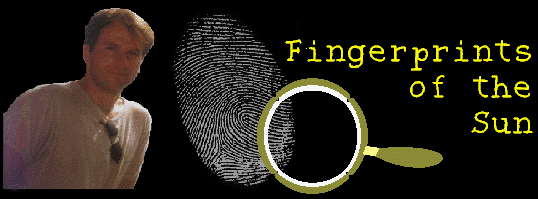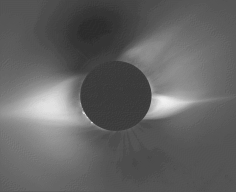

My name is Peter and I work in Cambridge. My job is to try and find out how hot the solar atmosphere is and what it is made of. Not many people do this for a living, so am I crazy or just very lucky?
You may have heard it said that the Moon is made of blue cheese. Many years ago Horace Walpole seems to have had a similar idea for the Sun! What's amazing is that I can get somewhat closer to the truth than Walpole just by working in my office. I don't have to travel to the Sun or even send a robot to fetch me a sample so I can study it in the laboratory like they did for the Moon rocks.
I can find most of the answers by studying the spectrum of the Sun's light. Actually, on second thoughts, in a way someone did build a robot to help me in my work. It is the SOHO (*LINK*) spacecraft! Even though SOHO doesn't have to go to the Sun to collect a sample of the Sun's atmosphere, it does have to go into space to collect a sample of the Sun's ultraviolet (*LINK*) light.
I think of myself as a solar detective and that hidden in the Sun's light are the clues I need. You might say the Sun's spectrum is like a criminal's fingerprints. Detectives can find out about criminals by studying their fingerprints without meeting them face to face - perhaps just as well sometimes!
Nowadays there are other methods for identifying humans. The way these methods work might actually be closer to the way I work with sunlight. Can you recall hearing of any such techniques? Clue: re-arrange the letters DAN!
If you follow the clues at the bottom of the page I shall show you some fascinating results, but first see if you can answer these questions.

During a total eclipse most of the light from the Sun is blocked out by the moon. You see only the fuzzy glow around the black disk which comes from the Sun's atmosphere, called the solar corona Here's my favourite eclipse picture.


Surprised? So was everyone else - in fact, at first no one believed it. So what convinced them?
Follow me and I'll show you the evidence we have for such high temperatures, and also how to find out what the Sun is really made of.
 Clue 1:
The solar Frankenstein.
Clue 1:
The solar Frankenstein.
 Clue 2:
The ultraviolet Sun.
Clue 2:
The ultraviolet Sun.
 Clue 3: What are these fingerprints?
Clue 3: What are these fingerprints?
 Clue 4: So what is the Sun made of?
Clue 4: So what is the Sun made of?
 Clue 5: Why is the corona so hot?
Clue 5: Why is the corona so hot?


|